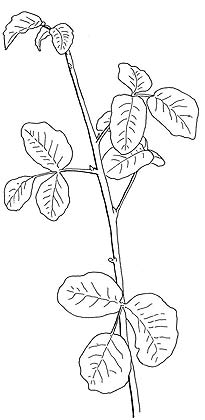
By David Wagner
 |
| Rhus diversiloba. Poison Oak |
Bright summery days inspire us to head outdoors to bask in the aura of abundant, green growth. Most flowers are past their peak of bloom and are setting seeds. Some make juicy berries, some produce capsules that quietly split open when dry. Others are a bit more vigorous in their dispersal. Standing quietly at midday on a hillside of Scots broom when its seed pods are ripe is like listening to a fireworks show. The drying pods gradually build tension between their two valves and when a breaking point is reached, they snap apart with a loud “pop,” sending seeds in all directions. If you are in an area where invasive plants are not to be tolerated, it is a sign that you are too late for broom control this year!
My pole beans are performing as desired, snaking up the poles in right handed spirals. I wonder if all pole beans have right handed spirals, like standard wood screws? As Darwin noted, most species with spiral stems twist in the same way; honey suckle always has a left handed twist, grapes to the right. The wild cucumber tendrils are different because they attach at the tip first, then twist to anchor the stem. To avoid twisting off, they spiral in one direction near the base and then change direction above.
Plant watchers need to be aware of the only serious danger of plant study, poison oak. The best cure is learn and keep away: “Leaflets three, leave them be.”
David Wagner is botanist who lives and works in Eugene. He teaches moss classes and leads nature walks. He may be reached at fernzenmosses@me.com